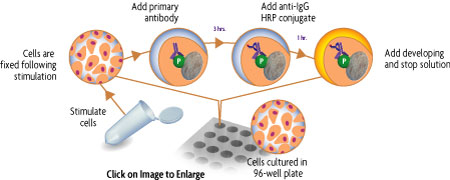THIS PRODUCT IS DISCONTINUED
Fast Activated Cell-based ELISA (FACE™) Kits provide a simple, sensitive method for detecting protein phosphorylation directly in the cell, without making extracts or performing electrophoresis and membrane blotting. These 96-well, high-throughput assays are available in both colorimetric and chemiluminescent formats for over 20 different targets (see list at right). For complete details, click the FACE™ Method tab below.
FACE JNK Kits provide 96 rxns each of 2 antibodies that enable you to monitor and compare the levels of both phosphorylated and total JNK (c-Jun N-terminal Kinase). The phospho-JNK antibody recognizes JNK1 only when phosphorylated at Thr183/Tyr185. The total-JNK antibody recognizes JNK1, JNK2 and JNK3 regardless of their phosphorylation states. Click the JNK Info tab below for data and more information.
| Name | Format | Cat No. | Price | |
|---|---|---|---|---|
| FACE™ JNK | 1 x 96 rxns | 48110 | Discontinued | |
| 5 x 96 rxns | 48610 | Discontinued | ||
| FACE™ JNK Chemi | 1 x 96 rxns | 48210 | Discontinued | |
| 5 x 96 rxns | 48710 | Discontinued | ||
| FACE™ JNK Manual |
| FACE™ Profile |
| Cell Biology Products Brochure |
| IsoCyte™ Application Note – Phospho-Protein Detection |
| MSDS: Sodium Azide |
| MSDS: Sulphuric Acid |
| MSDS: Thimersol |

Figure 1: Colorimetric measurement of phosphorylated and total JNK.Murine macrophage 4/4 cells were cultured in 96-well plates and serum-starved for 16 hours before stimulation. Cells were stimulated at the indicated concentrations of anisomycin for 15 minutes and then fixed. Total and phospho-JNK were each assayed in triplicate using the phospho and total JNK antibodies from the FACE JNK Kit. Data was plotted after correction for cell number (performed through use of Crystal Violet). Note that the induction treatment did not affect the overall level of total JNK.
Antibody Specificities
The phospho-JNK antibody is specific for phosphorylated JNK and was raised against a phospho-peptide that corresponds to the sequence surrounding Thr183/Tyr185 of human JNK. It recognizes JNK1 only when phosphorylated at Thr183/Tyr185, and JNK2 and JNK3 only when phosphorylated at equivalent sites. The total-JNK antibody recognizes JNK1, JNK2 and JNK3 regardless of the phosphorylation state.
JNK Overview
JNK (c-Jun N-terminal kinase), also called stress activated protein kinase (SAPK), is a member of the serine/threonine MAP kinase family. MAP kinase signaling cascades are critically important in translating the signals received at the plasma membrane into changes in cellular physiology and gene expression. JNK is activated in response to a variety of stimuli, including inflammatory cytokines, growth factors and cellular stresses such as UV-light. Because of JNK’s role in basic cellular processes such as inflammation and apoptosis, an understanding of the JNK signaling cascade should speed the development of therapeutics.
The FACE™ Method
In FACE, cells are cultured in 96-well plates and stimulated to induce the pathway of interest. Following stimulation, the cells are fixed rapidly, which preserves activation-specific protein modifications. Each well is then incubated with a primary antibody specific for the activated protein of interest. Subsequent incubation with secondary HRP-conjugated antibody and developing solution provides a colorimetric or chemiluminescent readout that is quantitative and reproducible (Figure 1). The number of cells in each well can be normalized easily with the provided Crystal Violet solution. FACE Kits also contain primary antibody specific for the native inactive protein, so you can monitor both native and activated protein levels in the same experiment. FACE eliminates cellular extractions, radioactive kinase assays, time-consuming Westerns and inefficient epitope interactions that occur on membranes. FACE is a highly sensitive high-throughput assay designed for detecting activated proteins within mammalian cells.
Figure 1: Flow chart of the FACE process.
Flow chart of the FACE in cell Western method that uses a cell based ELISA to measure the levels of the native and phospho forms of signaling proteins and kinases that are activated by phosphorylation.
Contents & Storage
Two (or ten) 96-well plates for culturing cells, 96 (or 5 x 96) rxns each of two primary antibodies (1 phospho-specific, 1 specific for native protein), HRP-conjugated secondary antibody, Quenching Solution, 1X Antibody Blocking Buffer, 1X Antibody Dilution Buffer, 10X PBS, 10% Triton X-100, 1% SDS Solution, Developing and Stop Solutions, and Crystal Violet Cell Quantification Solution. Storage conditions vary from room temperature to -20°C, see manual for details. All reagents are guaranteed stable for 6 months when stored properly.


